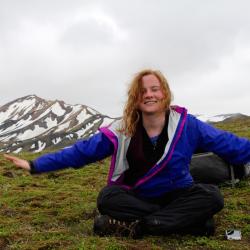Borganes is perhaps best known as the last‐chance gas and Bónus stop before the long drive onward to the remote Westfjords or the north of Iceland. Passing through, this diminutive town appears to have been dramatically sliced off just past the local N1 station. Today, though, Borgarnes will be different. After parking outside of the tourist information centre, Hrefna and I embark on a travel adventure, past the gas station and grocery stops, and into the city beyond.
Our first stop in Borgarnes is Café Kyrrð (“Café Tranquility”), which sits attached to the flower and gift shop Blómasetrið. Svava Víglundsdóttir, the owner, meets us at the door, immediately introducing us to her dog, Pinocchio, and a loitering cat named Amy Winehouse. Svava is welcoming—almost motherly—as we shake hands and fawn over the animals.
Svava takes us through a gorgeously decorated flower shop brimming with treasures, into the café. She sets rich, belly‐warming hot chocolates before us, following this wonderful surprise with waffles topped with whipped cream, jam, and chocolate.
Worldy and warm
Hrefna and I agree this place is special not only because of its unique and well‐crafted decorations, but because it isn’t trying too hard to be Icelandic. The focus is more on the general atmosphere, the Icelandic‐ness of which is provided by the sweeping view from the window. Later, Svava leads us through the rooms she rents upstairs, the decorations of which are also worldly and warm, with views just as spectacular as those on the lower floor.
With full stomachs and big smiles, we head down the street to Borgarfjörður museum. Guðrún Jónsdóttir, the museum’s curator, walks us through the current exhibit, ‘Children for 100 years’. Designed by Snorri Freyr Hilmarsson, a set designer, the museum contains dark grey walls, painted to mimic the pages of a scrapbook. Photos of Icelandic children throughout modern history are arranged sequentially atop them. Some of the photos even swing open, revealing related artefacts.
The second part of the exhibit begins with a child’s room in the early 20th century style. The room is fairly dark and very quiet, filled with beds and woollen blankets, obviously for a family rather than a single child. “I always ask people to be quiet for a few seconds,” says Guðrún, “so they can hear how silent it is in here, without the hum of a refrigerator or the sound of the television.” We let the silence settle over us.
The next room is a sharp contrast—a modern child’s room filled with sleek IKEA furnishings and toy dinosaurs. Discarded clothing is artfully arranged on the floor, so as to mimic the whimsy of prepubescent outfit changes. Guðrún tells us visitors will often fold the clothes, not realizing their haphazard arrangement is actually a part of the exhibit.
Adventures of birds
Next is the “Adventures of Birds” exhibit, also designed by Snorri. Featuring a wide variety of birds, the exhibit is another example of Snorri and Guðrún’s careful and innovative curation. The birds all face the same direction, and a series of mirrors washes into infinity, giving us a literal bird’s eye view.
Upstairs in the museum is both a library and an art exhibit. The current exhibit features works by Michelle Bird, an American artist currently living in Borgarnes. In the exhibit “Beloved Borgarnes,” Michelle paints local residents from photographs, residents she has come to consider friends, even family. She even painted a portrait of Svava’s daughter in exchange for a year’s worth of waffles.
The paintings are wild and ecological—American gothic done up in a Klimt‐esque style. A homey reality permeates them, as the subjects are often people Michelle knows well. She has been living in Borgarnes for about two years now, and after buying a house in the city, she began to invite artists to stay and collaborate with her through Fluxus Design Tribe. These collaborations have resulted in a wide series of projects, from a recycled‐material chandelier to an upcoming rewrite of Egil’s Saga.
Landtaking
After the Borgarfjörður museum, we move on to the famed Settlement Centre, a museum that contains exhibits on Egil’s Saga and Iceland’s early settlement years. Hrefna and I go through the Landnám (“land‐taking”) exhibit, armed with our audio guides. This exhibit also exudes a sense of creativity —at times, the floor changes density to mimic a more boggy location, and maps with lights allow guests to interact with the geographical scope of early settlement events.
Eírikur, a guide at the museum, tells us about a new Locatify feature, an app that acts as an audio guide to various historic sites around the Settlement Centre. Most of these sites have to do with the early childhood of the rebel‐poet Egill, the violent yet lovable main character of Egil’s Saga. His father, the grouchy Skallagrímur, lived in Borgarnes, and his burial mound can be sat upon today.
After our morning in the city, Hrefna and I both wish we could stay deeper into the day. But mostly, we wish that each of the times we’d pulled over for gas in previous years, we’d taken a few hours to look around at all the riches Borgarfjörður has to offer.
Buy subscriptions, t-shirts and more from our shop right here!























